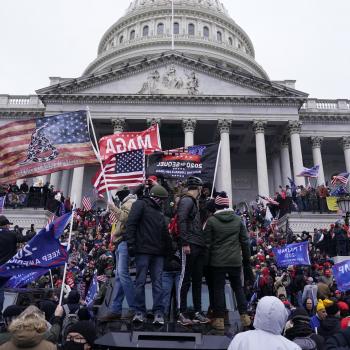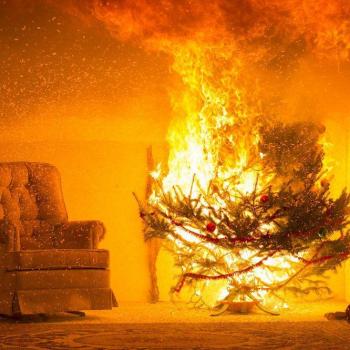You’ve heard of a food desert– those areas across America that have limited access to fresh, affordable food; often because all of the small, local stores have failed to thrive in an age of megastores; and yet, there are no megastores for miles (and miles and miles) around.
Food is not the only thing hard to access in some of these places. It’s just perhaps the most pressing the need, the most prevalent, everyday thing. But any other number of things are hard to come by, if you live in a place that is both remote and economically challenged. Healthcare. Libraries. The arts. Education beyond K-12 (and sometimes, even that). These things can all be scarce in certain corners –and in those certain corners, there is another reality we don’t often hear named– the church desert.
To be clear, let’s not confuse a church desert with a desert church. A desert church is a church that is physically located in a desert– say, in Arizona. A church in an arid climate, that has cactus in the landscaping, and stores its liturgical candles in the fellowship hall fridge, right next to the juice for communion. The a/c bill is often more than the outreach budget, but otherwise it’s a beautiful place to be.
A church desert, on the other hand, is a place where your choices of worshipping community are limited. It’s not that there aren’t churches there. Lord knows, small towns and rural areas often have more than their fair per-capita share of steepled buildings and changeable letter signs. The problem is that those churches might not be what you’re looking for; diversity of belief is a rarity. Just like the small grocery store that sells only convenience food, the church that is nearest your home might not have the basic amenities that you need to feed your spiritual life. And if that is the case– where do you go?

Like food deserts, a church desert is created by a number of factors– large portions of the population (and younger people) flocking to urban areas; and larger corporations (read: denominations) investing their resources primarily in those larger population centers. Look at any feasibility study for a new church plant in a small town or rural area, and it’s likely going to say to run for the hills.
The sad truth is that, in recent decades, progressive–and even mildly moderate– churches in small town and rural America have lost the culture wars. As their younger members grow up and leave home, their ranks are not replaced by new people moving to town. Many in the community who *might* want a more open approach to faith have been jaded by fundamentalism at some point and just avoid church entirely. Mainline decline plays a role, for sure. Churches split over political divides, or they just close.
I don’t want to get into the weeds about how this trend has come about; nor do I want to imply that this reality is absolute, across the board. Of course, there are examples of churches that defy the odds and ‘make it,’ doing wonderful, transformative ministry not in spite of, but in the midst of, their unique context.
But what I do know is this: there are many (many, many) Americans living in places where the nearest church that has women in leadership is an hour away. The closest place that might occasionally talk about racial or economic justice as a gospel issue is two hours away. The nearest church that welcomes gay people is three hours away.
And that- is a church desert.
I know folks who do, in fact, drive that hour or so to get to a faith community where they feel seen and included; where their spiritual needs are met in a place that feels safe. But more than hour? Most folks just sit it out. They try to carve out some hodgepodge of a spiritual life and community on their own. And that can be wonderfully life-giving.
But what if it’s not enough? What if you still crave belonging in a church body, need that connection point in order to be healed, to find meaning, and to grow?
A study (now a few years old) showed that West Virginia had the highest percentage of youth in the country that identified as transgender. Now… I love West Virginia. It’s a beautiful state with gorgeous landscapes, hospitable people, and unique culture. But… can you imagine being a transgender kid at a public school in small town West Virginia? At a Baptist or Pentecostal church in West Virginia? The weight of that ‘otherness’ literally costs some kids their lives.
What about the young woman who may feel called to preach, but has never witnessed a woman even praying in public at her church in the rural Midwest? What if you’re a single parent in small town Oregon, and the only ministry for people your age is all happily-married, Leave it to Beaver couples talking about how they find time for date night with their busy schedules?
What if you just have some doubts and some questions that are not safe to bring to the only church in Anytown, USA?
These are things that keep me up at night. But this right here is where the door is wide open. Maybe we got here kicking and screaming, but like it or not, church is remote now. Even the most low-tech/anti-tech congregations have had to figure out ways to be ‘together’ while distancing. Could it be that the crisis of this pandemic has offered us a glimpse of what the future of ‘church’ might look like on the other side?
Small towns and rural communities have wonderful things to offer – and any number of reasons that folks might choose to stay and make a life there, even if they are missing a church home. But why should that mean the church can’t come to them? How can progressive churches be doing outreach right now to folks who live beyond their geographical reach? People in the mountains and the prairies; people on farms and in hollers; and yes, those in deserts, both geographic and spiritual? Now’s the time to be getting out there with the message that there is a place for you, even if it may not be a physical building in your own hometown. This is a great opportunity for the Body of Christ to be who we’ve always said we are — a global presence that transcends time and physical place.
I’m not entirely sure what this looks like, but I know it’s something our churches need to start being intentional about, right now and not later. Are we prepared to maintain a digital presence even after the buildings open again? What have we learned about meaningful connection points in spite of distance? Who has been joining us remotely that we may never meet in person- and how do we make sure there’s still a place for them here once we are back in the house with the praise band? Is there a budget for targeted advertising that might reach the people in need of our message?
Are we prepared for this new mission field that has unfolded right in front of us?
Yeah, these are the things that keep me up at night. But in a good way.
Here’s the thing about the desert. In scripture, the desert is a place where the Holy Spirit is strongly present. Blowing things around, making noise, and surprising people who never saw her coming. It seems she might be moving in some desert places right now, and if that’s true… well, all we have to do is figure out how to show up.












